At OrthoSmile our team of specialists are renowned for their work with braces, dental implants in the "Aesthetic Zone", cosmetic porcelain veneers, ceramic crowns, Invisalign clear braces, and gum contouring surgery. Our dentist team have been educating in the field of cosmetic dentistry for decades and continuing to lead the way in the advancement of cosmetic dental materials, cosmetic periodontal surgery and cosmetic dental implant reconstructions in Thailand.
is a type of dental restoration which completely caps or encircles a tooth or dental implant. Crowns are often needed when a large cavity threatens the ongoing health of a tooth. They are typically bonded to the tooth using a dental cement. Crowns can be made from many types of materials, which are usually fabricated using indirect methods. Crowns are often used to improve the strength or appearance of teeth.
Dental bridge is a dental restoration used to replace a missing tooth by joining permanently to adjacent teeth or dental implants.
Type of bridge
Traditional bridges involve creating a crown for the tooth or implant on either side of the missing tooth, with a pontic in between. Traditional bridges are the most common type of bridge and are made of either porcelain fused to metal or ceramics.
Cantilever bridges are used when there are adjacent teeth on only one side of the missing tooth or teeth.
Maryland bonded bridges (also called a resin-bonded bridge or a Maryland bridge) are made of plastic teeth and gums supported by a metal framework. Metal wings on each side of the bridge are bonded to your existing teeth.
Material used for the crowns & bridges
Full metal/gold
Porcelain fused to metal/gold
All ceramic
Duration of crown and bridge treatment : 2-3 appointments
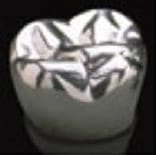
Metals with either silver or gold appearance does not mimic the look of real teeth. These traditional restorations has been used for decades.
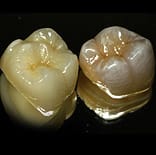
Porcelain, fused to an underlying metal structure comes closer to the look of real teeth than metal restorations. Metal substructure limits translucency sometimes resulting in restorations looking dull and lifeless.

Achieves the beauty and translucency of natural teeth. Produces strong, durable restorations. Could be an alternative for those who have concerns about metal.
Strong, attractive and compatible: You expect the best
There are not many materials, such as natural diamond, which combine exceptional beauty and strength. In dentistry, there has been continuous research and development to find materials suitable for dental prosthesis that are aesthetically acceptable, of sufficient strength and which are perfectly tolerated by the human body. For many years ceramic materials combined with metals have been used in dental restorations, ceramic to achieve the desired aesthetics, metal for strength.
A high-tech ceramic, Zirconium Oxide, is now available and has already been proven in many extreme situations such as heat shields in the Space Shuttle, brake disks for sports cars and the spherical heads of artificial hip joints. This high-tech ceramic has the potential to give prosthetic care a whole new image, because thanks to Cercon smart ceramics it can now be used in dentistry.
With the Cercon system, all-ceramic crowns and bridges of up to four units can be made in the incisal and molar regions. In individual cases, depending on the gap of the bridged teeth, even bridges of up to six units are possible. Additional dental applications are already in the testing phase and are just awaiting test results.
Until now, zirconium oxide could only be processed at great expense because of its exceptional hardness and was thus prohibitive for use as a dental prosthesis.
As the result of progress of a research project carried out by the renowned Zurich Federal Institute of Technology, is it now possible to use this material economically in dental technology.
A wax form or model of your “new teeth” is created in the dental laboratory, to the precise specifications provided by your dentist. This wax form serves as the pattern from which a computer-aided milling unit creates your crown or bridge from a solid zirconium oxide blank.
A ceramic veneer in your individual tooth colours is then applied to the milled zirconium oxide unit to achieve the desired characteristics and natural looking appearance. The Cercon system operates safely and flawlessly, with everything coming from one source - DeguDent.
If you would like to learn more about the fascinating steps involved in creating a dental restoration from Cercon smart ceramics, please contact our dentists.
Sheer high-tech brilliance for the best results Until now, zirconium oxide could only be processed at great expense because of its exceptional hardness and was thus prohibitive for use as a dental prosthesis. As the result of progress of a research project carried out by the renowned Zurich Federal Institute of Technology, is it now possible to use this material economically in dental technology. A wax form or model of your “new teeth” is created in the dental laboratory, to the precise specifications provided by your dentist. This wax form serves as the pattern from which a computer-aided milling unit creates your crown or bridge from a solid zirconium oxide blank. A ceramic veneer in your individual tooth colours is then applied to the milled zirconium oxide unit to achieve the desired characteristics and natural looking appearance. The Cercon system operates safely and flawlessly, with everything coming from one source - DeguDent. If you would like to learn more about the fascinating steps involved in creating a dental restoration from Cercon smart ceramics, please contact your dentist or his dental technical laboratory.
Set value on true quality In addition to a better appearance there are other features that determine the result and longevity of your investment that serve as a particular standard for quality. With Cercon smart ceramics, these quality standards are not just met but re-established. A Cercon dental restoration makes no compromises in aesthetics, compatibility, durability and function.
All the facts on Cercon smart ceramics for you at a glance
Due to the white zirconium oxide milled substructure
Thanks to the specially developed veneering porcelain Cercon®ceram S
Optimal shade match to the existing natural teeth
Can be contoured to blend with the natural dentition
Verified by the medical application of zirconium oxide for about 20 years
No allergic reactions reported in the published literature
No interaction with other dental materials
Good insulating behavior of the ceramic against cold/warm influences
Thanks to a smooth ceramic surface that supports good oral hygiene
Thanks to the exceptional strength of zirconium oxide
High stability requiring minimum framework dimensions
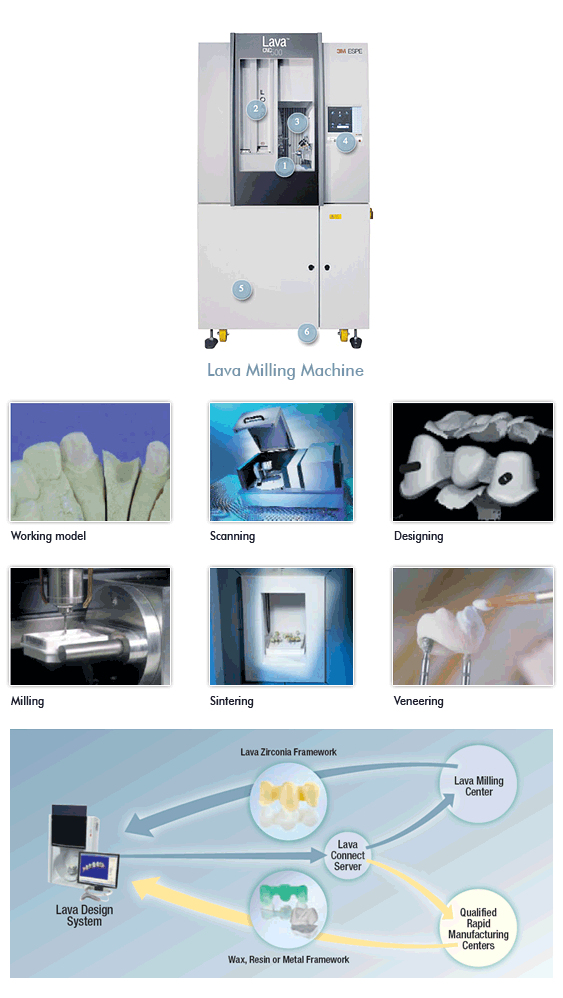
The 3M ESPE Lava system is an innovative CAD/CAM technology that uses a zirconium oxide base for all-ceramic crowns and bridges. The esthetics of Lava restorations with flexural strength similar to traditional porcelain fused to metal crowns, 3M Lava restorations are some of the strongest, most esthetic restorations available today.
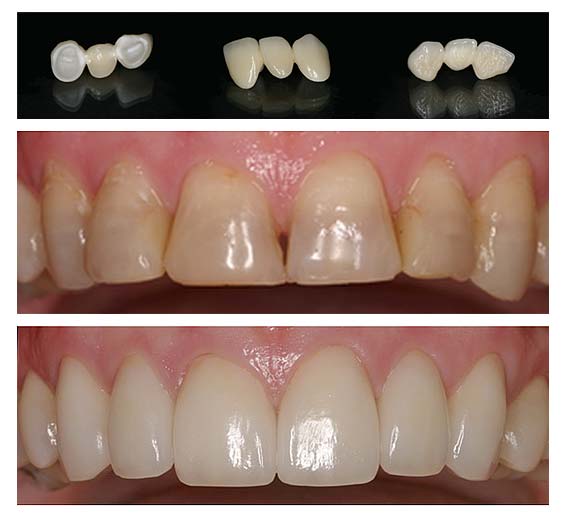
Lava restorations are made with Lava zirconia and are designed and milled with the innovative Lava CAD/CAM system. The combination of materials and precision milling produces a strong restoration with an excellent marginal fit.
Lava Crowns and Bridges from 3M ESPE have been established as a leading brand in CAD/CAM-produced zirconia restorations through its precise fit, proven strength and natural aesthetics.

An indirect restoration, also called a crown or bridge, is used to cover or replace a tooth that is broken, discolored, badly shaped or has too much decay for a filling
The restoration is fitted over the original tooth after any decay has been removed
The right restoration will look, feel and last like your natural teeth
“Beauty that lasts like no other restoration”
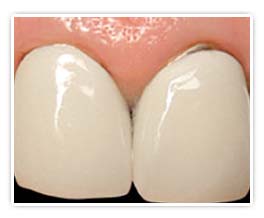
Over time, metal restorations can leave a dark ridge where the gums recede.

With Lava zirconia, your restoration retains its original beauty for years.
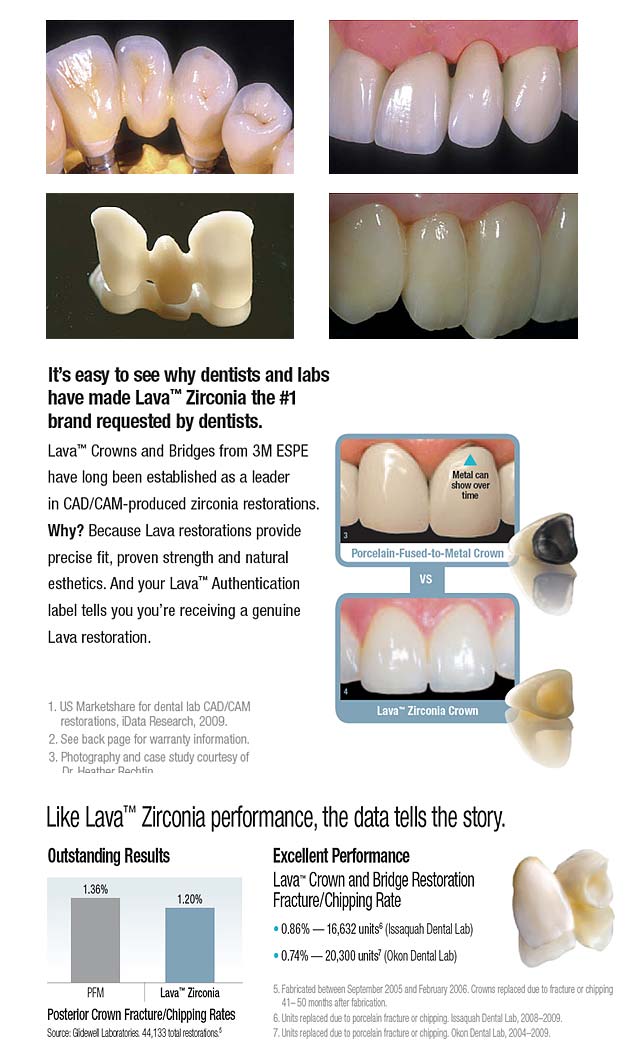
Full mouth LAVA all ceramic crowns done by Dr.Ken Kasidis
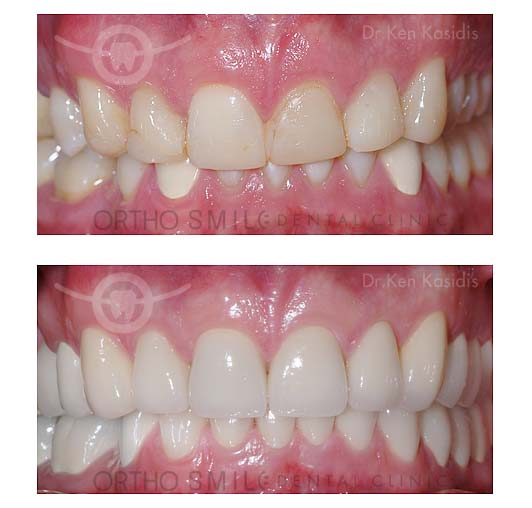
Pictures show the use of Lava 3M all ceramic crowns for full mouth rehabilitation.
Notice the beautiful, natural-looking dental crowns with the Lava all ceramic system.
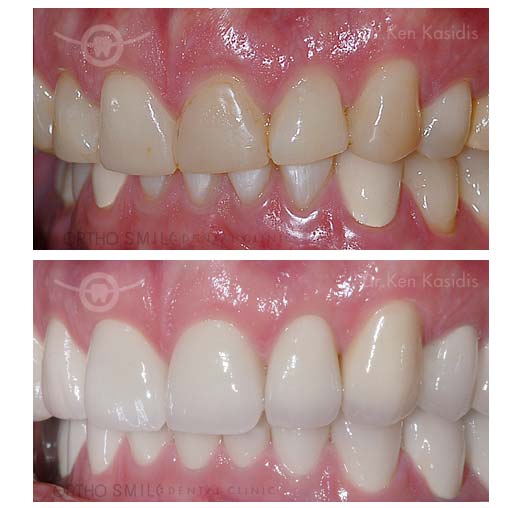
Lithium disilicate (LS2) glass-ceramic is ideally suitable for the fabrication of monolithic single-tooth restorations. This innovative ceramic provides highly esthetic results and, compared to other glass-ceramics, demonstrates a strength that is 2.5 to 3 times higher. Supported with zirconium oxide, it may also be used for bridges in the posterior area. The material is used in the dental laboratory in conjunction with either the press or the CAD/CAM technology. Given the high strength of 360-400 MPa, the restorations offer flexible cementation options. Depending on the patient situation, the restorations may be veneered in a highly esthetic manner or, if fabricated as monolithic restorations, stained. Even if the preparations demonstrate a dark shade (e.g. as a result of discolouration or titanium abutments), all-ceramic restorations may be fabricated. Inform your laboratory about the die shade and the dental technicians then selects the IPS e.max lithium disilicate material in the required opacity in order to redesign the true-to-nature esthetic appearance.
Thin veneers (0.3 mm)
Minimally invasive inlays and onlays
Partial crowns and crowns
Implant superstructures
3-unit anterior/premolar bridges (only IPS e.max Press)
3-unit bridges (zirconium-oxide supported only IPS e.max CAD)
True-to-nature shade behaviour for highly esthetic solutions
Durable restorations due to the high strength
Minimally invasive preparation for treatment that is gentle to the tooth structure
Versatile use and comprehensive range of indications
Lifelike esthetics, irrespective of the shade of the preparation
Adhesive, self-adhesive or conventional cementation depending on the indication
The lithium disilicate ceramic (LS2) of the IPS e.max system shows that esthetics and strength can be successfully combined. This is particularly true in single-tooth restorations, because this innovative ceramic produces esthetic results, while it is 2 ½ to 3 times stronger than other glass-ceramics.
Lithium disilicate has many uses. Its indication spectrum ranges from thin veneers (0.3 mm) and minimally invasive inlays and onlays to partial crowns, full crowns and threeunit anterior bridges. Of course, implant superstructures can also be produced with this material.
Because of its high strength of 360 - 400 MPa, restorations fabricated with this material can be cemented with different methods.
Due to their natural-looking colour and optimal light transmission, lithium disilicate restorations offer highly esthetic solutions. Depending on the needs of the patient, the restorations can be veneered with a highly esthetic material or they can be fabricated to full contour and then economically characterized.
Even if the tooth’s core is dark in colour (eg discoloured stump or titanium abutments), you no longer have to resort to zirconium oxide or metal-ceramic solutions. You can inform the dental laboratory about the colour that needs to be masked and the dental technician in charge will choose the IPS e.max lithium disilicate material with the required opacity to restore the natural esthetic appearance of the tooth.
Highly esthetic solutions
Long-lasting restorations due their high strength
Versatile use and very wide range of indications
Lifelike esthetic results − irrespective of the colour of the prepared tooth
Adhesive, self-adhesive and conventional cementation
IPS e.max Press is an innovative lithium disilicate glass-ceramic (LS2) ingot for the press technology. The innovative IPS e.max Press lithium disilicate glass - ceramic (LS2) provides accuracy of fit, function and esthetics while simultaneously featuring a strength of 400 MPa. The ingots are available in four levels of translucency, two sizes and now also as Impulse ingots. The result is a lifelike esthetic appearance irrespective of the shade of the preparation. HT ingots (High Translucency) The HT ingots are available in 16 A-D and 4 Bleach BL shades. Given their high translucency, they are ideal for the fabrication of smaller restorations (e.g. inlays and onlays). They can efficiently be individualized using the staining technique. LT ingots (Low Translucency) The LT ingots are available in 16 A-D and 4 Bleach BL shades. Given their low translucency, they are ideal for the fabrication of larger restorations (e.g. posterior crowns). They impress users with their lifelike brightness value and chroma. The appearance is further maximized by means of the cut-back technique. MO ingots (Medium Opacity) The MO ingots are available in 5 group shades (MO 0-MO 4). Given their opacity, they are ideally suitable for the fabrication of frameworks on vital, slightly discoloured preparations. They provide an excellent basis for lifelike restorations fabricated with the help of the layering technique. HO ingots (High Opacity) The ingots are available in 3 group shades (HO 0-HO 2). Given their high opacity, they are ideally suitable for the fabrication of frameworks on severely discoloured preparations or titanium abutments. They mask the dark subsurface and enable highly esthetic results. Impulse ingots (Value, Opal) The new Impulse ingots are available in 3 Value (Value 1, 2, 3) and 2 Opal shades (Opal 1, 2). They are mainly used for the fabrication of thin veneers, veneers, table tops, partial and single crowns. Depending on the favoured processing technique (staining, cut-back or layering technique) and the respective patient situation, a suitable ingot can be found. Individual characterization or veneering is carried out using the coordinated stains and layering materials of the IPS e.max Ceram veneering ceramic. For processing of IPS e.max Press in the EP3000 and EP5000 press furnaces, the two investment materials IPS PressVEST and IPS PressVEST Speed are available.
High strength (400 MPa) and high esthetics
Minimally invasive, accurately fitting restorations
Four levels of translucency and additional Impulse ingots for maximum flexibility
Lifelike esthetics, irrespective of the shade of the preparation
Adhesive, self-adhesive or conventional cementation depending on the indication
(Thin) veneers
Minimally invasive inlays/onlays (1 mm)
Partial crowns and crowns
Bridges in the anterior and premolar region
implant superstructures